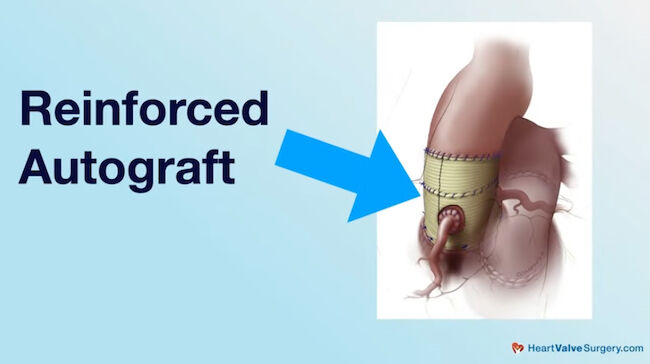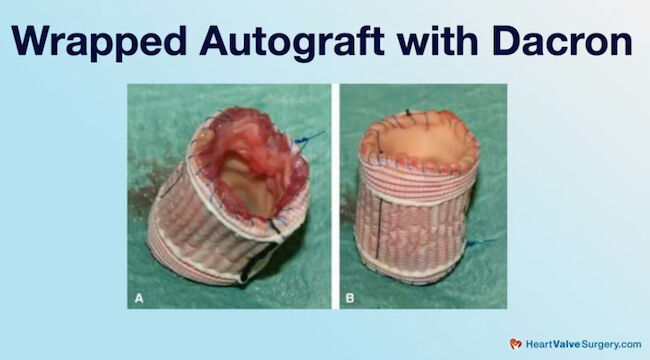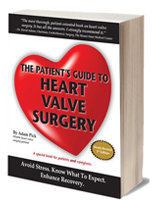Ross Procedure Innovation: Reinforcing the Pulmonary Autograft with Dacron
Written By: Allison DeMajistre, BSN, RN, CCRN
Medical Expert: Christopher Burke, MD, Ross Procedure Surgeon, UW Medicine, Seattle, Washington
Reviewed By: Adam Pick, Patient Advocate, Author & Website Founder
Published: July 8, 2025
The Ross Procedure, also called the “Switch Procedure”, is a promising option for children and young adults who need aortic valve replacement. The operation uses the patient’s own pulmonary valve, known as an autograft, to replace the aortic valve. A tissue valve, or homograft, replaces the pulmonary valve.
Given recent research, the Ross Procedure has been shown to provide patients a durable, long-term solution that won’t require lifelong blood-thinning medications. However, the pulmonary autograft is under significantly more pressure in the aortic position which can create complications. For that reason, cardiac surgeons may reinforce the pulmonary autograft with a Dacron graft during surgery which may prevent possible reoperation.
To learn more about reinforcement of the pulmonary autograft during the Ross Procedure, we spoke to Dr. Christopher Burke, a leading Ross Procedure surgeon UW Medicine Heart Institute in Seattle, Washington. As a surgeon specializing in Ross operations, Dr. Burke recognizes several considerations and choices go into the surgery, including whether to reinforce the autograft. We were thrilled to have Dr. Burke share his thoughts on this important topic.
Pulmonary Autograft Reinforcement Using Dacron
Here are key insights shared by Dr. Burke:
- What are complications of autograft dilation after a Ross Procedure? “This is a very hot topic these days,” said Dr. Burke. “One of the things we’ve known for a while is that over time, the autograft can dilate, and this can lead to aneurysms of the aortic root and aortic regurgitation and cause late failure and reoperation of the Ross Procedure.”
- What do surgeons consider when planning to protect the autograft from dilation? “Surgeons have thought about how to minimize the risk of late failure and reoperation,” said Dr. Burke. “One of the ways we do it is by wrapping the autograft with the Dacron graft. There are a variety of techniques that one can use. This has the obvious advantages of protecting the autograft and preventing dilation. But, like anything, this comes with some potential drawbacks. It increases the technical complexity of an already complex operation, so you have to consider that. The coronary arteries can be a little bit of a challenge to place inside of a graft. And then one thing we don’t know is how the delicate autograft leaflets tolerate the stiff, rigid structure over time.”

- A personalized approach is the key to successful treatment. Dr. Burke explained that they have devised a tailored approach based on each patient’s anatomy and specific factors. “We will really individualize how we treat and potentially wrap or protect the autograft,” he said. “Because we know that a one-size-fits-all approach is probably not ideal. A lot of patients do perfectly well with just a freestanding autograft implant. So, we take our highest risk patients with aortic regurgitation or root aortic aneurysms and protect those patients with a Dacron wrap.”

- During their conversation, Adam Pick, the founder of HeartValveSurgery.com, pointed out that he had a Ross Procedure with a Dacron graft. Adam told Dr. Burke, “I’m now nearly 20 years out from my Ross Procedure with no reoperation or reintervention.”
Thanks Dr. Burke and UW Medicine!
On behalf of all the patients in our community, thank you Dr. Christopher Burke, for everything you and your team are doing at the UW Medicine Heart Institute!
Related links:
- See the new Ross Procedure Patient Education Center
- Ask Dr. Burke: Evolution of a Ross Procedure Program
- Heart Warrior: Andy’s Ross Procedure Patient Story
Keep on tickin!
Adam
P.S. For the deaf and hard-of-hearing members of our patient community, we have provided a written transcript of our interview with Dr. Burke below.
Video Transcript:
Adam Pick: Hi everybody! It’s Adam with HeartValveSurgery.com and we’re in Los Angeles, California at the Society of Thoracic Surgeons Conference. I am thrilled to be joined Dr. Chris Burke, who is a leading aortic valve surgeon at UW Medicine Heart Institute in Seattle, Washington. Dr. Burke, we have known each other for a while. It is great to see you here at STS and thanks for being with me today.
Dr. Chris Burke: It’s great to see you Adam. Thank you.
Adam Pick: You and I were just having a conversation all about the Ross Procedure. As a surgeon that specializes in the Ross operation, you have considerations and choices. One component of the Ross is whether-or-not to reinforce the autograft, which is the new aortic valve. I’m real curious to know your thoughts on that topic and if you could share them with the patients in our community.
Dr. Chris Burke: This is a very hot topic these days as you’re well aware. One of the things that we’ve known now for a while is that over time, the autograft can dilate and this can lead to aneurysms of the aortic root and aortic valve regurgitation.
This can be a cause of late failure and reoperation.
Surgeons have thought how to minimize this risk. One of the ways that we do it, as you point out, is wrapping the autograft with the Dacron graft. There’s a variety of techniques that one can use. This has the obvious advantage of protecting the autograft and preventing that dilation.
But like anything this does come with some potential drawbacks. It does increase the technical complexity a little bit of an already complex operation. So, you have to consider that. The coronary arteries can be a little bit of a challenge sometimes to place inside of a graft. And then, one thing that we don’t know is, how do those delicate autograft leaflets tolerate that stiff, rigid structure over time? And we just don’t know.
So, we have really come up with a tailored, patient specific approach that’s based on patient factors and anatomy. We will really individualize how we treat and potentially wrap or protect the autograft. Because we know that a one size fits all approach is probably not ideal. A lot of patients do perfectly well with just a freestanding autograft implant.
So we take our highest risk patients, those that come in with aortic regurgitation or have root aortic aneurysms, and we’ll protect those and do a Dacron wrap on those patients.
Adam Pick: I can tell you, Dr. Burke, I had a Ross procedure that had a wrap, a Dacron graft to it. I’m now nearly 20 years out from my Ross with no reoperation and no reintervention.
I can’t thank you and your team for doing all the research, all the studying and mastering those techniques to help these patients with that very complex Ross procedure. On behalf of them and all the patients at HeartValveSurgery.com. Thank you and your team at UW Medicine in Seattle, Washington.
Dr. Chris Burke: Thank you, Adam.





